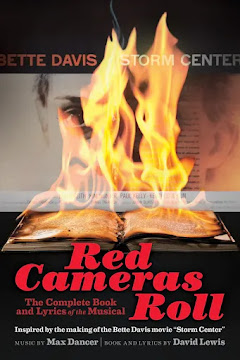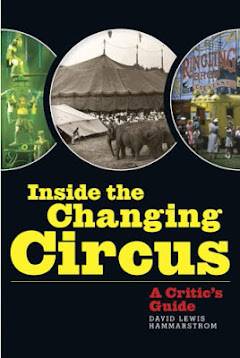
My little litmus test, whenever I pick up a new book about circus, is to look in the index for the names of Irving J. Polack or Louis Stern.
 Almost always, they are missing. Almost always, once again ignored by those press agents or fans or operatives (as mostly they are) who write these books that are rarely questioned by the people who review them. Does it even matter, many will ask, yawning off. It’s only the circus. Well, if as they say the victors in war get to write their own history, what can we expect under tents of popular amusement so far removed from urgent matters of life and death — of stock market crashes and presidential elections? Not much. To me it matters, and so, buckle down and get ready for a little shock therapy over sawdust.
Almost always, they are missing. Almost always, once again ignored by those press agents or fans or operatives (as mostly they are) who write these books that are rarely questioned by the people who review them. Does it even matter, many will ask, yawning off. It’s only the circus. Well, if as they say the victors in war get to write their own history, what can we expect under tents of popular amusement so far removed from urgent matters of life and death — of stock market crashes and presidential elections? Not much. To me it matters, and so, buckle down and get ready for a little shock therapy over sawdust.
 How are circus books written? Notwithstanding the scholarly treatments (although they too tend to distort issues in the heat of pc-induced epiphanies), usually they are penned in one of three manners: Author scratching backs of those who have either scratched his or will in return; Former press agent goes to work (like lobbyists are known to do) for ex-boss with puff prose, maybe getting something under the table or hoping for future employment.
How are circus books written? Notwithstanding the scholarly treatments (although they too tend to distort issues in the heat of pc-induced epiphanies), usually they are penned in one of three manners: Author scratching backs of those who have either scratched his or will in return; Former press agent goes to work (like lobbyists are known to do) for ex-boss with puff prose, maybe getting something under the table or hoping for future employment.
Circus fans just can’t bring themselves to utter a down word. Or there’s the well-intentioned writer simply lacking in the basics of American circus history. It is not with relish but with a deference to respect for the neglected Mr. Polack and Mr. Stern, that I am about to step onto some tender toes. Somebody must. And If I am wrong, be my guest and step right back. But keep the expletives to yourself or you will be escorted into this midway's mandatory anger management course hosted in the big cage by Clyde Beatty.
Messrs. Polack and Stern have gotten shockingly little respect from libraryland. In John Culhane’s acclaimed The American Circus: An Illustrated History (that’s the one that reprints the Irvin Feld press kit by eliminating Art Concello from the picture), the name Polack Bros. Circus gets dropped a few times, but only in passing when a few of the acts who appeared with it are mentioned. In the cheerfully embracing, if not always reliable Step Right Up, by LaVahn G. Hoh and William H. Rough, whose text, claim the authors, was combed for accuracy by a brigade of historians, there is not a single reference to Polack or Stern or their circus. Ditto Ernest Albrecht’s seriously informative The New American Circus. And now we have The Circus: Garden of Eden-Pittsburgh (some of you, who have installed this magnificent piece of furniture in your home, will know it simply as The Circus: 1870-1950). This latter tome at least contains a few index entries for Polack Bros. Circus. Stern or Polack themselves? Nothing.

But, still, I keep looking. Out there in cyberspace, there is an ambitious new circus website that longs to be the end-all in on-line research for circus buffs and nerds, launched by Big Apple Circus. A lovely layout, it calls itself Circopedia. With promises to grow in coverage and scope, so far it is woefully incomplete and blatantly selective in who and what gets attention. And in predictably telling ways. No surprise that Paul Binder, who for many years employed the site’s principal contributor, Dominique Jando, merits a lush and adoring multi-paragraph tribute. We'll skip the glaring absence of John Ringling North, about which it's a given that Binder, no lover of three rings, would not have much to say. But nothing on Guy Laliberte? Now, this is tantamount to a ballet website failing to profile Sergei Diaghilev. In fact, Binder was a preservationist, not essentially an innovator.
Circopedia, (in which, presumably because it is cyber fluid, the names of Stern and Polack may one day yet appear) makes a rather bold claim that Mr. Binder’s show “reintroduced the one ring circus to America.” This is a little like the impression left in Mr. Albrecht's book, for it, too, seems curiously unaware of Polack Bros history, a subject most germane to Mr. Albrecht’s focus.
 Let me tell you, if I must be the one, about the fine producing team of Polack and Stern. During the Great Depression, they operated essentially a carnie circus. Stern had a conscience attack and talked his partner into cleaning up their vision. Or getting one. They pioneered a then radically new concept and took the idea to Shrine Temples, seeking sponsorships: A one ring circus. They produced some of the best ring performances ever, signing a steady succession of ex-Ringling stars, who themselves had been imported from abroad. The great Barbette, a true visionary, directed some of the Polack shows. In his memorable 1953 opus, Barbette inserted an enchanting little ballet, Carnival in Spangleland. The show drew big crowds; In San Francisco, it played 10-day engagements at the Civic Auditorium. It covered the U.S. with two units, the Eastern and the Western, each one touring for ten to eleven months. Some circusgoers preferred it to the mighty Ringling.
Let me tell you, if I must be the one, about the fine producing team of Polack and Stern. During the Great Depression, they operated essentially a carnie circus. Stern had a conscience attack and talked his partner into cleaning up their vision. Or getting one. They pioneered a then radically new concept and took the idea to Shrine Temples, seeking sponsorships: A one ring circus. They produced some of the best ring performances ever, signing a steady succession of ex-Ringling stars, who themselves had been imported from abroad. The great Barbette, a true visionary, directed some of the Polack shows. In his memorable 1953 opus, Barbette inserted an enchanting little ballet, Carnival in Spangleland. The show drew big crowds; In San Francisco, it played 10-day engagements at the Civic Auditorium. It covered the U.S. with two units, the Eastern and the Western, each one touring for ten to eleven months. Some circusgoers preferred it to the mighty Ringling.
And then came to these shores, in 1963, the even more mesmerizing example of a one ring powerhouse in the form of the Moscow Circus. Three seasons later, Famous Circus Bartok was born. Sarasota based, it patterned itself after European styles by, among other things, placing its band above the performer’s entrance. The Russians returned in 1967 and played to sold out crowds in Oakland. I should know; I was one of hundreds turned away. The stage was more than set for the likes of the Pickle Family Circus, which followed in 1974, and Big Apple's first date, three seasons later.
Will Irving J. Polack and Louis Stern ever receive their just due? Thanks to the internet, they surely will -- the moment I click "publish" on this post. Oh, what wishful thinking.

[Polack Bros. Circus photos, from top: The 1955 program magazine cover; Irving J. Polack in a photo from the Showmen's League of America, for whom he served as president in 1947; Louis Stern in 1955; La Norma in 1953; Barbette's Carnival In Spangleland, 1953: Seen here are clowns Chester and Joe Sherman, dancer Marilyn Hightower, and Ronnie Johnarud; The Ward-Bell Flyers, 1953]
First published 2/27/09






















6 comments:
Couldn't agree more on the importance of Polack Bros shows. It's a bit like trying to tell the story of the traditional circus after the mid-50's without discussing Mills Bros and sponsors contracts.
When push comes to shove I'd wager there have rarely been stretches of significant time when one ring shows haven't actually out-numbered three-ring shows in the US. Unlike excellent shows like Polack, many were probably single family wagon shows, or small indoor shows, some good, some not so good...but they were circus. (Those Baraboo boys partnering with Yankee Robinson didn't squeeze three rings into their forty foot tent that first season.) Certainly circa 1900-1920 there were some excellent "Society Circus" efforts put out in the winter by grand circus names like Rhoda Royal. And producers and owners like Charles Hunt toured with single ring shows for years. Like most "'Pedias" depending on user created content I imagine the BAC effort will morph through the years. As soon as I find a few free days I fully intend to write about the storied history of the peanut pitch from George Washington Carver to George Washington "Popcorn George" Hall.
Show Biz,
Having a "conscience attack" and mobbing up with the Shrine, is similar to a street dealer having a "conscience attack" and mobbing up with Pablo Escobar. It just makes your operation bigger.
Wade Burck
Bill, I got your comment and thought I posted it. For some reason, it never came through. Send it again if you will.
The history of Polack Circus and I J and Louie Stern are a book themselves. For longjivity and quality. No greater group of outstanding acts have ever been or ever will be seen in yje American one ring circus. And the human interest stories are fabulous. For example, I J Polack was a gambler and loved a crap or poker game in the mens dressing room and one time he lost the whole circus on a throw of the dice to Bo Bo Barnett and later Bo Bo lost it back to him on another turn of the dice. Louie called the names of his great acts his own version. He and Pat Anthony had a hilarious relationship and etc. Yes it was a great circus and certainly its roster over the years would be a Whos Who in the circus biz. including Unus, Fraces Bruan, Victor Julian. You name em and how right you are. Of course the great Orrin Davenport is also American circus history as a great bareback rider, equestrian director and pioneer of Shrine-indoor circuses. Thanks for brininging all this to attention.
In "the old days" grade schools had what were called patrol boys. I was one and as a reward we were taken to the Medinah Shrine Temple in Chicago to see the 1961 edition of Polack Bros. We had 3rd row seats and what a production it was. It sparked my interest and helped to send me on a career in this biz.
Seems when I saw the great Polack Bros Circus in the Oakland Auditorium in the 50's 60's It had 3 rings. Such a great entertainment event. The lights,live music great acts. You will never see anything like that again. They traveled all over California .I wonder If anyone ever did a 16mm film on the Polack Bros Circus?
Post a Comment